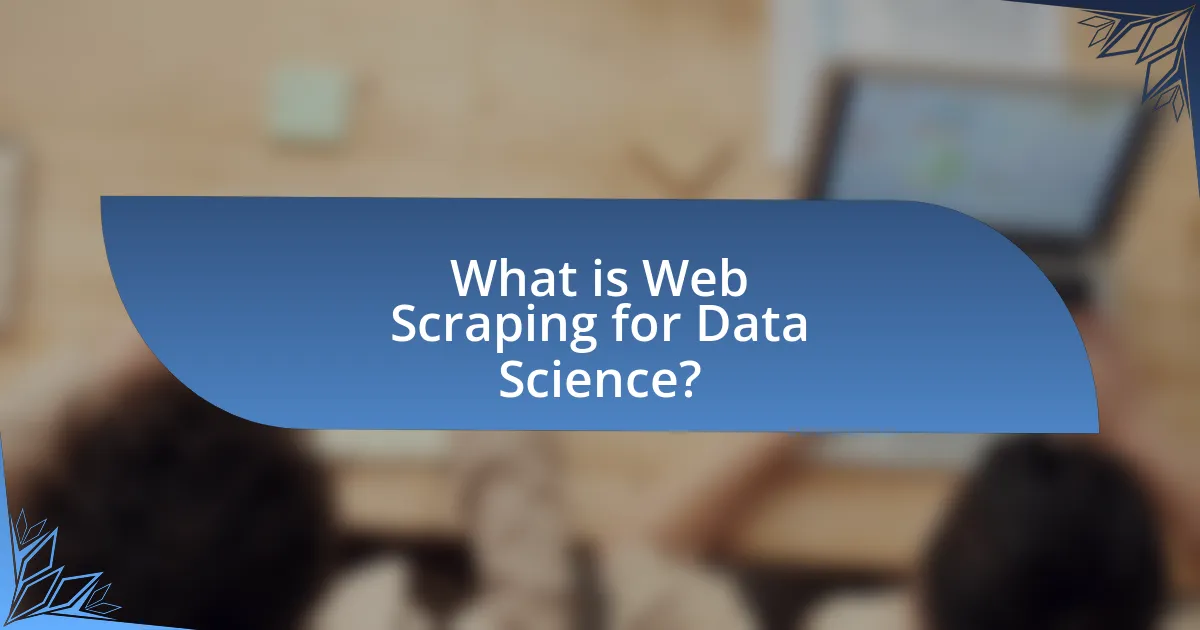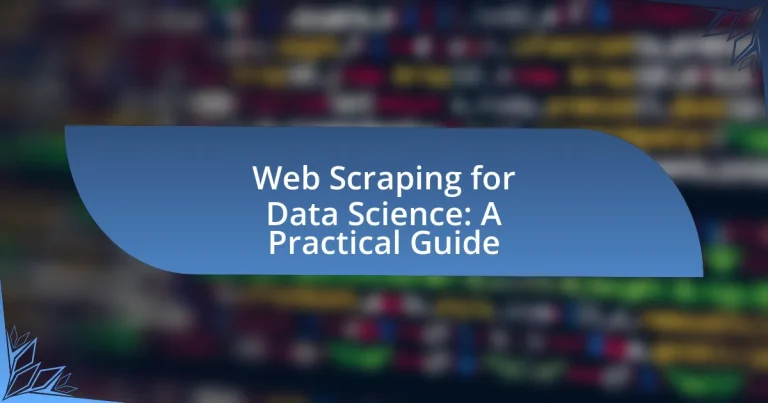Web scraping for data science is the automated extraction of data from websites, enabling data scientists to analyze unstructured web content for insights. This article outlines the significance of web scraping in the data science workflow, detailing key stages of data collection, fundamental concepts, and common tools used in the process. It also addresses ethical considerations, challenges faced during scraping, and best practices for implementation. Furthermore, the article explores practical applications of web scraping in market research, sentiment analysis, and competitive analysis, highlighting its role in enhancing data-driven decision-making.

What is Web Scraping for Data Science?
Web scraping for data science is the automated process of extracting large amounts of data from websites to analyze and derive insights. This technique enables data scientists to gather structured data from unstructured web content, facilitating tasks such as market research, sentiment analysis, and trend identification. According to a 2021 report by Statista, 79% of organizations leverage web scraping for data collection, highlighting its significance in data-driven decision-making.
How does web scraping fit into the data science workflow?
Web scraping is a critical component of the data science workflow as it enables the extraction of large volumes of data from websites for analysis. This process allows data scientists to gather real-time information, which can be used for various applications such as market research, sentiment analysis, and trend forecasting. For instance, a study by the Pew Research Center highlights that 79% of data scientists utilize web scraping to collect data for their projects, demonstrating its prevalence and importance in the field. By integrating web scraping into the data science workflow, professionals can enhance their datasets, leading to more informed decision-making and insights.
What are the key stages of data collection in data science?
The key stages of data collection in data science include defining objectives, identifying data sources, data acquisition, data cleaning, and data storage. Defining objectives involves determining the specific questions or problems that the data collection aims to address. Identifying data sources requires locating relevant datasets, which can be obtained from APIs, databases, or web scraping. Data acquisition is the process of gathering the data from the identified sources, while data cleaning involves removing inaccuracies and inconsistencies to ensure data quality. Finally, data storage refers to organizing and saving the cleaned data in a suitable format for analysis. These stages are essential for effective data collection and contribute to the overall success of data science projects.
How does web scraping enhance data collection methods?
Web scraping enhances data collection methods by automating the extraction of large volumes of data from websites, which significantly increases efficiency and accuracy. Traditional data collection methods often involve manual processes that are time-consuming and prone to human error, whereas web scraping tools can systematically gather data from multiple sources in real-time. For instance, a study by the Pew Research Center found that automated data collection can reduce the time spent on data gathering by up to 80%, allowing researchers to focus on analysis rather than data acquisition. This capability not only streamlines the process but also enables access to diverse datasets that may not be readily available through conventional means.
What are the fundamental concepts of web scraping?
The fundamental concepts of web scraping include data extraction, HTML parsing, and data storage. Data extraction involves retrieving information from web pages, typically using automated tools or scripts. HTML parsing refers to the process of analyzing the structure of web pages to identify and extract relevant data elements, often utilizing libraries like Beautiful Soup or Scrapy in Python. Data storage is the final step, where the extracted information is saved in a structured format, such as CSV, JSON, or a database, for further analysis or use. These concepts are essential for effectively gathering and utilizing data from the web for various applications in data science.
What tools and technologies are commonly used in web scraping?
Commonly used tools and technologies in web scraping include Python libraries such as Beautiful Soup, Scrapy, and Requests, as well as browser automation tools like Selenium. Beautiful Soup is widely recognized for its ease of use in parsing HTML and XML documents, while Scrapy is a powerful framework designed for large-scale web scraping projects. Requests simplifies the process of making HTTP requests, and Selenium allows for interaction with web pages that require JavaScript execution. These tools are validated by their extensive use in the data science community, as evidenced by numerous tutorials and case studies demonstrating their effectiveness in extracting data from various websites.
How do different web scraping techniques compare?
Different web scraping techniques vary in complexity, efficiency, and use cases. For instance, HTML parsing is straightforward and effective for static websites, while API scraping is more efficient for structured data retrieval from web services. In contrast, browser automation tools like Selenium can handle dynamic content but require more resources and setup. A study by the University of California, Berkeley, highlights that while HTML parsing is faster for simple tasks, API scraping can yield higher data accuracy and completeness, making it preferable for large-scale data extraction.
What ethical considerations should be taken into account?
Ethical considerations in web scraping include respecting copyright laws, adhering to terms of service, ensuring user privacy, and avoiding data misuse. Copyright laws protect the intellectual property of content creators, meaning scraping copyrighted material without permission can lead to legal repercussions. Adhering to the terms of service of websites is crucial, as many explicitly prohibit scraping activities. User privacy must be respected, particularly when handling personal data, to comply with regulations like GDPR, which mandates consent for data collection. Finally, avoiding data misuse ensures that scraped information is not used for harmful purposes, such as identity theft or misinformation. These considerations are essential for maintaining ethical standards in data science practices.
Why is it important to respect website terms of service?
Respecting website terms of service is crucial because these agreements outline the legal framework governing the use of a website’s content and services. Violating these terms can lead to legal repercussions, including lawsuits or being banned from accessing the site. For instance, many websites explicitly prohibit automated data scraping, and ignoring such restrictions can result in significant penalties. Additionally, adhering to these terms fosters ethical practices in data collection, ensuring that data scientists maintain trust and integrity in their work.
How can web scrapers avoid legal issues?
Web scrapers can avoid legal issues by adhering to the terms of service of the websites they scrape, ensuring compliance with copyright laws, and respecting robots.txt directives. By reviewing and following a website’s terms of service, scrapers can identify any restrictions on data usage and scraping practices. Compliance with copyright laws is crucial, as unauthorized use of copyrighted material can lead to legal repercussions. Additionally, respecting robots.txt directives helps scrapers understand which parts of a website are permissible to access, thereby minimizing the risk of legal action. These practices are supported by legal precedents, such as the case of hiQ Labs, Inc. v. LinkedIn Corp., where the court emphasized the importance of terms of service in determining the legality of scraping activities.
How can one effectively implement web scraping?
To effectively implement web scraping, one should utilize a programming language like Python along with libraries such as Beautiful Soup and Scrapy. These tools allow for efficient extraction of data from websites by parsing HTML and XML documents. For instance, Beautiful Soup simplifies the process of navigating and searching through the parse tree, while Scrapy provides a robust framework for building web crawlers.
Additionally, it is crucial to respect the website’s robots.txt file to ensure compliance with its scraping policies, which helps avoid legal issues. According to a study by the University of California, Berkeley, ethical web scraping practices can significantly reduce the risk of being blocked by websites. Therefore, implementing web scraping effectively involves using the right tools, adhering to ethical guidelines, and ensuring compliance with website policies.
What are the common challenges faced during web scraping?
Common challenges faced during web scraping include dealing with anti-scraping measures, handling dynamic content, and managing data quality. Anti-scraping measures, such as CAPTCHAs and IP blocking, are implemented by websites to prevent automated data extraction, making it difficult for scrapers to access the desired information. Dynamic content, often loaded via JavaScript, requires specialized tools or techniques to extract data effectively, as traditional scraping methods may not capture this content. Additionally, data quality issues arise from inconsistent formatting, missing values, or duplicate entries, necessitating further data cleaning and validation processes to ensure the accuracy and reliability of the scraped data.
How can data quality issues be addressed in web scraping?
Data quality issues in web scraping can be addressed by implementing validation checks, data cleaning processes, and using reliable data sources. Validation checks involve verifying the accuracy and completeness of the scraped data against predefined criteria, ensuring that only high-quality data is retained. Data cleaning processes, such as removing duplicates, correcting inconsistencies, and standardizing formats, further enhance data quality. Additionally, utilizing reliable data sources minimizes the risk of scraping erroneous or outdated information, as reputable websites typically maintain higher data integrity. These methods collectively improve the overall quality of data obtained through web scraping.
What strategies can be used to handle anti-scraping measures?
To handle anti-scraping measures, implement strategies such as rotating IP addresses, using headless browsers, and employing CAPTCHA-solving services. Rotating IP addresses helps to avoid detection by distributing requests across multiple addresses, thereby reducing the risk of being blocked. Headless browsers simulate real user behavior, making it harder for websites to identify scraping activities. Additionally, CAPTCHA-solving services can bypass automated challenges that websites use to prevent scraping. These strategies are effective as they mimic legitimate user interactions, thereby minimizing the chances of triggering anti-scraping defenses.

What are the practical applications of web scraping in data science?
Web scraping has several practical applications in data science, including data collection for market research, sentiment analysis, and competitive analysis. For instance, businesses utilize web scraping to gather pricing information from competitors’ websites, enabling them to adjust their pricing strategies effectively. Additionally, researchers employ web scraping to collect large datasets from social media platforms for sentiment analysis, which can reveal public opinion trends on various topics. According to a study published in the Journal of Data Science, web scraping can significantly enhance the quality and quantity of data available for analysis, thereby improving the accuracy of predictive models.
How is web scraping used in market research?
Web scraping is used in market research to collect large volumes of data from websites, enabling businesses to analyze competitor pricing, customer reviews, and market trends. By automating the extraction of relevant information, companies can gain insights into consumer behavior and preferences, which informs product development and marketing strategies. For instance, a study by Statista indicates that 79% of companies utilize web scraping to enhance their market intelligence efforts, demonstrating its effectiveness in providing actionable data for decision-making.
What types of data are typically scraped for market analysis?
Market analysis typically involves scraping data such as product prices, customer reviews, competitor information, and market trends. This data is essential for understanding market dynamics and consumer behavior. For instance, scraping product prices allows businesses to perform competitive pricing analysis, while customer reviews provide insights into consumer sentiment and preferences. Additionally, gathering competitor information helps in identifying market positioning and strategies. Market trends data, often sourced from social media and news articles, aids in forecasting future market movements.
How can insights from scraped data influence business decisions?
Insights from scraped data can significantly influence business decisions by providing actionable intelligence that informs strategy and operational adjustments. For instance, companies can analyze competitor pricing, customer sentiment, and market trends derived from scraped data to optimize their pricing strategies, enhance product offerings, and improve customer engagement. A study by McKinsey & Company found that data-driven organizations are 23 times more likely to acquire customers, 6 times more likely to retain customers, and 19 times more likely to be profitable. This demonstrates that leveraging insights from scraped data can lead to informed decision-making that drives business growth and competitive advantage.
What role does web scraping play in competitive analysis?
Web scraping plays a crucial role in competitive analysis by enabling businesses to gather large volumes of data from competitors’ websites efficiently. This data can include pricing information, product offerings, customer reviews, and marketing strategies, which are essential for understanding market positioning and trends. For instance, a study by Statista indicates that 79% of companies use web scraping to monitor competitors, highlighting its significance in strategic decision-making. By analyzing this scraped data, companies can identify gaps in their own offerings, adjust pricing strategies, and enhance customer engagement, ultimately leading to improved market competitiveness.
How can companies leverage scraped data to gain a competitive edge?
Companies can leverage scraped data to gain a competitive edge by analyzing market trends, customer preferences, and competitor strategies. By collecting and processing data from various online sources, businesses can identify emerging trends and consumer behavior patterns that inform product development and marketing strategies. For instance, a study by McKinsey found that companies using data analytics to drive decision-making can achieve productivity gains of 5-6%. Additionally, scraped data enables companies to monitor competitor pricing and promotional strategies in real-time, allowing for agile adjustments to their own pricing models. This data-driven approach not only enhances operational efficiency but also fosters innovation, ultimately leading to a stronger market position.
What metrics can be derived from web scraping for competitive insights?
Web scraping can derive several key metrics for competitive insights, including pricing analysis, product availability, customer sentiment, and market trends. Pricing analysis involves collecting competitor prices to identify pricing strategies and market positioning. Product availability metrics reveal stock levels and product offerings, helping businesses understand competitor inventory strategies. Customer sentiment can be gauged through reviews and social media mentions, providing insights into brand perception and customer satisfaction. Market trends can be identified by analyzing the frequency of product launches, promotional activities, and seasonal trends, allowing businesses to adapt their strategies accordingly. These metrics enable companies to make informed decisions based on real-time data from competitors.
How does web scraping contribute to academic research?
Web scraping significantly contributes to academic research by enabling the collection of large datasets from online sources, which can be analyzed for various studies. Researchers utilize web scraping to gather data from websites, social media platforms, and online databases, facilitating the exploration of trends, patterns, and correlations in fields such as social sciences, economics, and health. For instance, a study published in the Journal of Data Science demonstrated that web scraping allowed researchers to analyze public sentiment on social media regarding health policies, providing insights that traditional survey methods could not capture. This method enhances the scope and depth of research by providing access to real-time data and diverse information sources.
What types of academic projects benefit from web scraping?
Academic projects that benefit from web scraping include data analysis, market research, sentiment analysis, and academic research. Data analysis projects utilize web scraping to gather large datasets from various online sources, enabling researchers to identify trends and patterns. Market research projects leverage web scraping to collect competitor pricing, product information, and consumer reviews, which inform business strategies. Sentiment analysis projects benefit from web scraping by extracting opinions from social media and review sites, allowing researchers to gauge public sentiment on various topics. Lastly, academic research projects often use web scraping to compile data for literature reviews, meta-analyses, and other scholarly inquiries, enhancing the depth and breadth of research findings.
How can researchers ensure the reliability of scraped data?
Researchers can ensure the reliability of scraped data by implementing validation techniques such as cross-referencing with authoritative sources and employing data cleaning methods. Cross-referencing involves comparing scraped data against trusted datasets or official records to identify discrepancies, which enhances accuracy. Data cleaning methods, including removing duplicates, correcting errors, and standardizing formats, further improve data quality. According to a study published in the Journal of Data Science, effective data validation can increase the reliability of datasets by up to 30%, demonstrating the importance of these practices in web scraping.

What are the best practices for web scraping?
The best practices for web scraping include respecting website terms of service, implementing rate limiting, using user-agent rotation, and handling data responsibly. Respecting terms of service ensures compliance with legal and ethical standards, as many websites explicitly prohibit scraping in their policies. Implementing rate limiting prevents overwhelming the server, which can lead to IP bans; for instance, a common practice is to limit requests to a few per second. User-agent rotation helps avoid detection by mimicking different browsers, thus reducing the risk of being blocked. Finally, handling data responsibly involves anonymizing personal information and ensuring compliance with data protection regulations, such as GDPR, to protect user privacy.
How can one ensure ethical web scraping practices?
To ensure ethical web scraping practices, one must adhere to the website’s terms of service and robots.txt file, which outline the rules for automated access. Respecting these guidelines is crucial, as they indicate the site’s permissions regarding data extraction. Additionally, obtaining explicit consent from website owners when necessary fosters transparency and trust. Ethical scrapers should also limit the frequency of requests to avoid overwhelming servers, which can disrupt service for other users. Furthermore, anonymizing data to protect user privacy and ensuring compliance with data protection regulations, such as GDPR, reinforces ethical standards in web scraping.
What guidelines should be followed to respect website owners?
To respect website owners, adhere to the following guidelines: always check and comply with the website’s terms of service, which often outline permissible data usage. Additionally, implement polite scraping practices by limiting the frequency of requests to avoid overwhelming the server, and utilize the robots.txt file to identify which parts of the site are off-limits for scraping. These practices are essential as they help maintain the integrity of the website and foster a respectful relationship between data scrapers and website owners.
How can scrapers minimize their impact on website performance?
Scrapers can minimize their impact on website performance by implementing techniques such as rate limiting, using efficient algorithms, and respecting robots.txt directives. Rate limiting involves controlling the frequency of requests to avoid overwhelming the server, which can be achieved by spacing out requests over time. Efficient algorithms reduce the amount of data processed and the number of requests made, thereby decreasing server load. Additionally, adhering to robots.txt directives ensures that scrapers only access permitted areas of a website, further reducing unnecessary strain on server resources. These practices collectively help maintain website performance while allowing scrapers to gather the needed data.
What tools and libraries are recommended for web scraping?
The recommended tools and libraries for web scraping include Beautiful Soup, Scrapy, and Selenium. Beautiful Soup is a Python library that simplifies the process of parsing HTML and XML documents, making it easier to extract data from web pages. Scrapy is an open-source framework designed for web scraping that provides a robust set of features for handling requests, parsing responses, and storing data. Selenium is a tool that automates web browsers, allowing users to interact with web pages and scrape dynamic content that requires JavaScript execution. These tools are widely used in the data science community for their efficiency and effectiveness in gathering web data.
What are the advantages of using Python for web scraping?
Python offers several advantages for web scraping, including its simplicity, extensive libraries, and strong community support. The language’s straightforward syntax allows developers to write and maintain code efficiently, which is crucial for scraping tasks that often require quick iterations. Additionally, libraries such as Beautiful Soup, Scrapy, and Requests provide powerful tools for parsing HTML and managing HTTP requests, streamlining the scraping process. Furthermore, Python’s active community contributes to a wealth of resources, tutorials, and forums, making it easier for users to troubleshoot issues and share knowledge. These factors collectively enhance Python’s effectiveness and popularity in web scraping applications.
How do different libraries compare in terms of functionality?
Different libraries for web scraping, such as Beautiful Soup, Scrapy, and Selenium, compare significantly in terms of functionality. Beautiful Soup excels in parsing HTML and XML documents, making it ideal for simple scraping tasks where data extraction is needed from static pages. Scrapy, on the other hand, is a comprehensive framework that supports asynchronous requests, allowing for efficient scraping of large websites and handling of multiple pages simultaneously. Selenium is designed for automating web browsers, making it suitable for scraping dynamic content that requires interaction with JavaScript elements. Each library’s unique strengths cater to specific scraping needs, with Beautiful Soup being user-friendly for beginners, Scrapy offering robust features for large-scale projects, and Selenium providing capabilities for complex, interactive sites.
What troubleshooting tips can enhance web scraping success?
To enhance web scraping success, ensure that you handle HTTP errors effectively by implementing retries and checking response codes. This approach allows scrapers to recover from temporary issues like server overloads or rate limiting, which can occur frequently during scraping sessions. For instance, a study by the University of California, Berkeley, highlights that implementing exponential backoff strategies can significantly reduce the number of failed requests, improving overall data retrieval efficiency. Additionally, using user-agent rotation can help avoid detection and blocking by websites, as many sites monitor for scraping activity based on user-agent strings.
How can common errors in web scraping be resolved?
Common errors in web scraping can be resolved by implementing robust error handling and validation techniques. For instance, using try-except blocks in Python can catch exceptions that occur during the scraping process, allowing the program to continue running or to log errors for later review. Additionally, validating the structure of the scraped data against expected formats can help identify discrepancies early, ensuring data integrity. According to a study by the University of California, Berkeley, effective error handling can reduce runtime failures by up to 30%, demonstrating the importance of these practices in maintaining reliable web scraping operations.
What resources are available for learning more about web scraping?
Comprehensive resources for learning about web scraping include online courses, books, and documentation. Websites like Coursera and Udemy offer structured courses on web scraping techniques using languages such as Python and R. Notable books include “Web Scraping with Python” by Ryan Mitchell, which provides practical examples and insights into scraping methodologies. Additionally, the official documentation for libraries like Beautiful Soup and Scrapy serves as essential references for understanding their functionalities and best practices. These resources collectively equip learners with the necessary skills and knowledge to effectively perform web scraping tasks.


